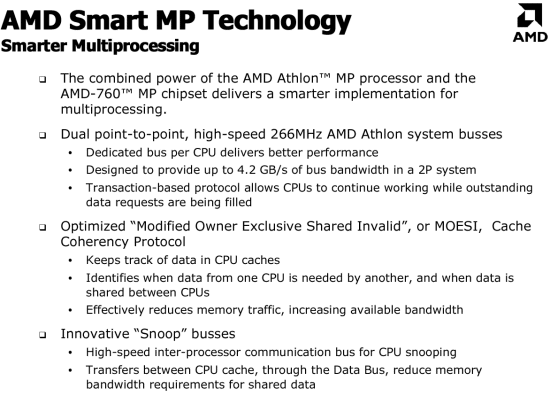Computex: AMD Releases 760MP Chipset For Dual AthlonMP
AMD SMP Technology - SmartMP
The SMP-capability of Athlon's architecture was obvious from the day when AMD disclosed that Athlon will use Alpha's EV6 processor bus. Athlon's processor bus is a point-to-point bus. This requires a processor bus for each CPU in case of multiple processor configurations, which increases manufacturing costs of motherboards, but it ensures full data bandwidth for each Athlon processor. Intel's processors, including the recently released Xeon 4, are using a shared bus architecture, which keeps motherboard production costs down, but it has the disadvantage that the processors have to share the processor bus bandwidth.
Due to time constraints I will supply you with additional information about AMD's SmartMP in form of an AMD paper. I apologize and promise to give my own evaluation at a later point in time.

You could say that AMD's SMP solution has some clear performance advantages over Intel's SMP-architecture, but it is more expensive to implement due to the requirement of dedicated processor buses, which makes motherboard design complex and expensive. We will have a look at our benchmarks later to see if dual AthlonMP is indeed able to show an edge over Intel's dual Xeon 4.
The Benefits Of SMP
Multi processor systems are common for servers as well as complex workstations for a long time. However, so far the average home user was rather unable to get any benefit out of SMP. The first reason why the average PC-user won't be able to take much advantage of a multi processor system is the operating system. The most common OS today is Windows98, before it was Windows95 and many people today are using WindowsME. None of those three operating systems is able to support more than one system processor. If you want to get something out of a multi processor system, you require either Windows 2000, Windows NT, BeOS or one of the UNIX OSes, like e.g. Linux or FreeBSD. Then you need to either use certain software that is programmed for multi-threading, because normal software can't occupy more than one processor, or you have to be a person that uses many performance intensive programs at the same time. A single processor system is well able to run Excel, Word and PowerPoint at the same time without the urgent need nor benefit of an additional CPU. However, if you want to zip large directories or burn CDs while e.g. working with Word, you will indeed benefit from two processors, since one processor will be busy zipping or burning the CD, while the other is available to you for other workloads. If you neither use special workstation software, like e.g. 3D rendering or CAD, that has been designed for multi processor operation, nor run more than a few low profile programs at the same time, it is better to spend your money on one fast CPU rather than two slower CPUs. This is particularly important to 3D-gamers. Only Quake 3 and games that are based on the Quake 3 engine are currently able to take advantage of multi-processor system. All other 3D-games run just as fast with one as with two CPUs, unless you are running some other processor intensive software in the background.
The verdict remains the same. The majority of PC users will not benefit from SMP-systems. Performance crazy Quake 3 Arena gamers should have a good look at our benchmarks though.
Stay on the Cutting Edge
Join the experts who read Tom's Hardware for the inside track on enthusiast PC tech news — and have for over 25 years. We'll send breaking news and in-depth reviews of CPUs, GPUs, AI, maker hardware and more straight to your inbox.
Most Popular

